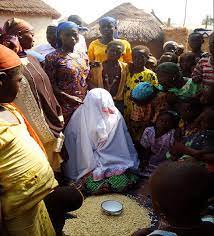Marriage rites among the Dagomba people are rich in tradition and meaning. These customs connect couples and strengthen the community. Each phase of the marriage process is important. Additionally, they reflect the values and beliefs of the Dagbon Kingdom.
This tradition is significant for the Dagomba people in Northern region of Ghana.It emphasizes lineage, moral values, and family unity. Therefore, understanding these customs helps us grasp their cultural identity. This article will also highlight the key aspects of the marriage process. Moreover, we will explore the importance of customs and the influence of modern practices.
In this blog, we will uncover the stages of marriage among the Dagomba people. First, we will look at courtship. Next, we will discuss engagement and the traditional ceremony. Each step holds deep significance. Furthermore, we will learn about the roles of elders and the community.
Get ready to discover their unique customs and the importance of love and marriage in their culture!
Key Stages of Marriage Rites in Dagbon
Marriage plays a vital role in ensuring family lineage continues. Additionally, marriage is essential for community growth. It strengthens bonds among families and promotes support within the community. Moreover, this cultural belief highlights the significance of marriage in Dagbon society.
1. Courtship (paga lagbu)
The marriage process begins with courtship, called paga lagbu. During this phase, a man shows interest in a woman. Additionally, he presents gifts to win her affection.

Also, this phase involves competition among suitors. They seek to impress her family. Often, they consult with the woman’s family. Sometimes, they use divination to select the best match. This process also highlights the importance of family and tradition in finding a partner.
2. Proposal (Paga tibu)
Once a suitor is chosen, the formal proposal occurs. This event is known as paga tibu. Furthermore, the suitor’s family visits the woman’s family. They often bring a respected elder called Chɛmlana.
This elder plays a crucial role. He helps gain the family’s approval. His presence also adds respect and seriousness to the proposal. Moreover, this step emphasizes the importance of family support in the marriage process.
3.Appreciation (Paga puhigu)
When the woman’s family agrees, the suitor’s family shows appreciation. They perform rituals and bring offerings. These offerings include a white fowl, alcohol, and cola nuts.
This stage is known as paga puhigu. It marks the official union of the couple. This tradition highlights the respect between families and solidifies their bond.
4. Celebration
A feast is organized to celebrate the union. Traditional music and dance fill the air. This creates a joyful atmosphere.
Moreover, community members join in the festivities. Their participation strengthens social bonds. It also fosters unity among everyone involved. Overall, this celebration brings the community together and highlights the importance of togetherness.
5. Sending of Bride to New Home
After the marriage is confirmed, the bride has some time with her parents. She may stay there until the groom’s family requests her presence. This request comes with cola and money.
Next, the families set a date for her to move in. The Dagomba people prefer Saturdays and Wednesdays for these events. They believe these days bring good fortune. This practice shows the importance of timing in their traditions. Overall, it reflects the strong connection between families.

6. Receiving of Bride
When the bride arrives at the groom’s house, she is welcomed with a feast. The groom slaughters a fowl. He prepares a delicious meal for the guests.
Next, the bride stays in her mother-in-law’s room for two days. During this time, she learns about her new responsibilities. This period is important for her adjustment. It helps her understand her role in the family. Overall, this celebration brings everyone together and strengthens bonds.
7. Virginity Test
A traditional practice occurs on the wedding night. Families check the bride’s virginity. They lay a white cloth down. If the cloth is stained with blood, it signifies purity. This practice holds great importance in the community.
The next day, the groom’s family takes action. They send a bowl of cola to the bride’s family. However, this gesture is a way to congratulate them. It also shows respect and happiness for the new union. Overall, these traditions strengthen family ties and celebrate love.
Important Cultural Aspects
The role of elders is crucial in the marriage process. Elders guide families through the rites. Their wisdom is highly valued by all. Moreover, they help resolve conflicts and offer advice.
In Dagbon culture, polygamous marriages are accepted. When there are multiple wives, the rites may vary. However, this flexibility reflects the community’s understanding of family dynamics.
Community involvement is also significant. Moreover, the whole community joins in the celebrations. This participation showcases their collective spirit. It also highlights the importance of relationships in Dagbon culture. Everyone supports the couple, creating a sense of unity and joy.
Read Also: 4 Roles of Traditional Healers in the Northern Region
7 Interesting Facts About the Rich Culture of Northern Region







